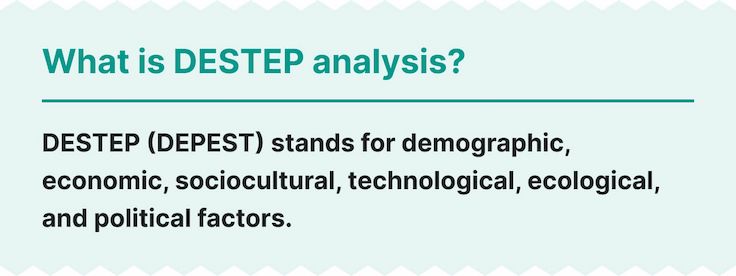DESTEP Analysis Template & Example
To use the DESTEP analysis template, perform 3 simple actions: fill in the gaps, pick the best design, and download the results. Let's learn more about the tool!
A DESTEP analysis tool helps comprehend the external environment and the problems that could impact a business. Leaders use this method to make fundamental decisions and stimulate the company's growth. You have to take these steps to conduct the DESTEP analysis:
- Understand the components under research.
- Examine the connections between various trends.
- Link the trends to the problems.
- Predict the future course of the issues.
- Conclude the results you have received.

📍 What Is DESTEP Analysis?
DESTEP is for demographic, economic, sociocultural, technological, ecological, and political factors. DESTEP (or DEPEST) analysis is a strategic business decision tool that incorporates significant external factors from the macro environment. The approach is commonly represented as a six-pillar structure or a two-by-three matrix and can be used in any industry. DEPEST analysis results highlight the sphere in a company that needs monitoring and improving.
What Is DESTEP Used for?
The DEPEST analysis aids businesses in understanding their external environment and the issues which may impact strategic plans.
- This research identifies key market factors and provides contextual details about the company's plans.
- When conducted with a big team, DESTEP analysis provides versatile results because different people have different backgrounds and experiences.
- DEPEST analysis is a helpful onboarding tool. The external elements affecting the business will be evident to new team members as soon as they join the team.
📝 How Do You Conduct a DESTEP?
As mentioned, each letter in the DEPEST analysis is associated with a business-influencing factor. These factors are very unpredictable, so the company has to be aware of the consequences they may cause.
☕ DESTEP: Example of Use
Starbucks is a massive chain of coffee shops in the world. The DESTEP analysis example of this famous brand might look as follows:
Demographic factors
Consumers of Starbucks are working-class people of middle age and people on the go. A significant percentage of this layer of people is financially stable, so the company has to focus more on this category of customers.
Economic factors
Coffee shops have not proven to be recession-proof, as evidenced by the financial crisis of 2008–2009. Most customers view Starbucks's coffee as a luxury rather than a necessity. The coffee shop has to be prepared to deal with inflation and set a price on coffee beans ahead of time.
Political factors
As a World Fair Trade Organization member, Starbucks must satisfy minimum per-pound price requirements for coffee beans. Coffee sent to the United States has minimal import taxes and tariffs. Also, there are no limits on the quantity of coffee imported into the US for commercial use.
Environmental factors
In the era of environmental consciousness and green movements, many businesses are under growing pressure to undertake green projects. The growing number of ecologically concerned customers are attracted to coffee businesses that use recycled paper and less plastic.
Sociocultural factors
Many people are becoming increasingly concerned about their health. As a result, they are seeking healthier food and beverage options. It is a good idea for Starbucks to provide low-calorie beverages and food and list nutrient info on their menus.
Technological factors
Using social media has increased the number of sales for Starbucks. Adding the capability for users of mobile devices to make barcode payments also has played a very significant role in the coffee shop development.
🌠 DESTEP Analysis Template Benefits
There are many advantages of using our automated instrument. The DESTEP analysis tool is:
- Quick and simple. It can help you complete the research in a few minutes without difficulties.
- Free. You can implement your ideas and save money at the same time.
- Visual. Do you like colorful diagrams and schemes? Then, the DEPEST analysis tool is perfect for you to frame your thoughts.
- Accurate. A considerable benefit of the tool is that it aids you in analyzing things in an exact and faultless way.
- Available on any device. You can use our tool on your computer or smartphone. All you need is an internet connection.
Thank you for reading this article! We hope that the information above was useful. Check our other online writing tools to polish your assignment or get inspired.
Updated:
🔗 References
- DESTEP Analysis: Your Guide To External Environment Analysis
- What Is A DESTEP Analysis? DESTEP Analysis In A Nutshell - FourWeekMBA
- Macro Environment - Overview, DEPEST Analysis, Factors
- What is Macro Environment Analysis?
- PESTEL Analysis - Industry Research - LibGuides at Washington State University